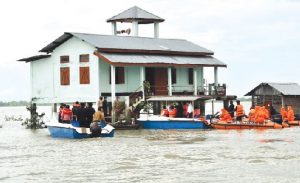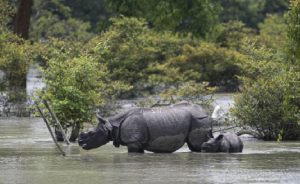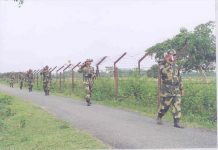 My 45-year-old aunt gets worried every time the monsoon arrives, marooning her entire village, Charaibahi Gaon, in Dibrugarh district of Assam. When she got married at the age of 19, she thought that one day the floods drowning her maternal village every year would calm down and never again ravage her life or the ones that she held dear.
My 45-year-old aunt gets worried every time the monsoon arrives, marooning her entire village, Charaibahi Gaon, in Dibrugarh district of Assam. When she got married at the age of 19, she thought that one day the floods drowning her maternal village every year would calm down and never again ravage her life or the ones that she held dear.
“How I wished I never had to face such floods in my life. I, your uncle, your grandmother and my two sons would have had a normal life, just like the one you have in Delhi,” says my aunt Anita Saikia over the phone.
In Assam, however, the flood inundated the villages and towns every year. And by the time the waters recede, the flooding water takes with it every piece of the house that my aunt’s family struggles so hard to build throughout the year. When the flash flood strikes, they move to a chang ghar — houses built on raised stilts — or take shelter on highways alongside their livestock. It is a common sight at the place where she lives — one of the most flood-prone districts of upper division of Assam, Dibrugarh, where one shower of torrential rains submerges the whole district.
“Imagine our pain. We can’t even get down from our chang ghar to use toilets. And, the coronavirus has made things even worse for us. This is nothing but our bad luck,” says my aunt.
According to her, the floods have been worse than ever this year and the water will not recede anytime soon. This is the third wave of flood in the last two months which has caused a massive destruction to the state. Now, the makeshift chang ghar is going to be the temporary shelter for my aunt and her family for next three to four months. Their own thatched house, partly made of concrete, is nearly submerged in the water. The cattle are being shifted to the highland which is being watched by my two cousin brothers. With them there are hundreds of other male members from the village, Charaibahi, with their bovines and other livestock, all taking shelter in the makeshift tarpaulin tents, waiting for the flood fury to calm down.
“Ba, I am towing twice in the day to check on them (family members), catching fish for them to eat, getting rations, some medicine and other essentials as they have nobody else to help them. On top of that, the mandatory social distancing has gone for a toss since flooding has pushed out people from their homes and the relief camps are too crowded for sheltering people,” says my younger cousin brother Ritu Saikia.
One Bitupan Barua from the same village complained of not getting enough support from the government. “We just got one round of supplies of essentials from the government 30 days ago. Since then, we haven’t heard of them…May be, because of the coronavirus they are afraid of coming to us,” says Barua.
 Back home in my grandmother’s chang ghar, my aunt wishes for a life away from floods and miseries. My 90-year-old grandmother has lost hope in the state government. If there is anyone who can rescue Assam, it is God, according to her belief. She prays hard for a normal life for her two grandsons, away from the annual deluge and the troubled village life. “Everything is underwater — our house, cereals and potatoes that we grew; our cattle and fowls are on the road…What if my two grandsons catch any infection due to the polluted flood water? God should at least bless them with a better life,” my grandmother grieves while talking to me over the phone.
Back home in my grandmother’s chang ghar, my aunt wishes for a life away from floods and miseries. My 90-year-old grandmother has lost hope in the state government. If there is anyone who can rescue Assam, it is God, according to her belief. She prays hard for a normal life for her two grandsons, away from the annual deluge and the troubled village life. “Everything is underwater — our house, cereals and potatoes that we grew; our cattle and fowls are on the road…What if my two grandsons catch any infection due to the polluted flood water? God should at least bless them with a better life,” my grandmother grieves while talking to me over the phone.
This year, the flood has affected 2,265 villages in Assam.
Assam incurs an average annual loss of 200 crore due to the recurring flood every year since 1950, yet the state’s disaster is far from being declared as a national calamity. When it comes to flood-hit Assam, the state fails to garner attention from the national media or public empathy outside the north-eastern region because of the common belief among the masses that floods are a part of life in Assam.
The nation’s conscience
The flood fury has turned catastrophic in Assam amid the Covid-19 pandemic as the damage is not just limited to people but also thousands acres of paddy and other crops, tea plantations, etc. The state has a rich resource of wildlife, flora and fauna, which are under imminent danger due to the unprecedented rise in the water levels. As per reports, the flood situation deteriorated after the Karbi Langpi Hydro Electric Project, situated in Karbi Anglong district, opened its gates to release at least 25 metres of water.
By July end, over 26.38 lakh people were displaced, as many as 123 people died, over 1.16 hectares of crop area were damaged and around 129 animals were killed (till the last reports). Also, the total number of confirmed Covid-19 cases were 31,086 in Assam as on 26 July, 2020.
The mighty Brahmaputra river and its tributaries that have been flowing above the danger mark have swept away dozens of districts in Assam — 27 of the 33 districts. Goalpara is the worst affected district with over 4.7 lakh people followed by Barpeta (4.24 lakh) and Morigaon (3.75 lakh). Other affected districts are Dhemaji, Lakhimpur, Biswanath, Darrang, Baksa, Nalbari, Chirang, Bongaigaon, Kokrajhar, Dhubri, South Salmara, Kamrup, Kamrup Metropolitan, Nagaon, Golaghat, Jorhat, Majuli, Sivasagar, Dibrugarh, Tinsukia and Cachar.
Tributaries that are mostly flowing above the danger levels are Dhansiri, Jia Bharali, Kopili, Beki and Sankosh at Golokoganj in Dhubri.
If all of this loss in Assam doesn’t awaken the conscience of mainstream media, what will?
Wildlife in danger
 About 92 per cent of the Kaziranga National Park and Tiger Reserve (KNPTR) and Pobitora Wildlife Sanctuary are reportedly under water. As a result, many wild animals have flocked to Karbi Hills in search of safe shelter and food, crossing National Highway 37. A total of 129 animals, including 12 one-horned rhinos, are reported to have died due to the flood and the number could go higher in the coming days once the flood starts to recede.
About 92 per cent of the Kaziranga National Park and Tiger Reserve (KNPTR) and Pobitora Wildlife Sanctuary are reportedly under water. As a result, many wild animals have flocked to Karbi Hills in search of safe shelter and food, crossing National Highway 37. A total of 129 animals, including 12 one-horned rhinos, are reported to have died due to the flood and the number could go higher in the coming days once the flood starts to recede.
In 2019, the state constructed 33 new highlands on 1.5 hectares area of the southern boundary of Kaziranga in the east-west direction for the wild animals to take refuge during annual deluge. It cost around 16 crores. The park already has 144 artificial highlands, first built in 1990. Today, over 77 per cent are in dilapidated condition.
However, the wildlife experts and conservationists argue that artificial highlands built inside the national parks for wild animals are not beneficial in the long-run and don’t represent a permanent solution. In fact, they are of the view that such highlands might damage the ecology of the park. The experts shared the concern after the Centre approved another sum of 12.5 crores for constructing a 32-km long artificial highland inside Kaziranga National Park.
Covid-19 making life harder
Ever since the monsoon flood has hit Assam in May, it has become a challenge for the authorities and community health workers to maintain the social-distancing norms among the flood victims and check the spread of malaria and Japanese Encephalitis as well. There have been a number of infection cases in shelter camps and many people even died owing to lack of proper facilities.
The total number of confirmed Covid-19 cases were 31,086 in Assam as on 26 July, 2020. According to Assam State Disaster Management Authority (ASDMA), around 269 relief camps and 188 relief distribution centres have been set up where approximately 45,912 people are taking shelter as of 26 July, 2020. The authorities claim to follow all the safety protocols inside the relief camps in view of the Covid-19 pandemic. However, reports of waters entering in some of the relief camps in Baghjan, Dighal Tarang and Guijan have emerged too.
Also, as per media reports, floodwaters could easily spread infection by carrying the discarded medical waste from hospitals and COVID care centres. The (ASDMA) has raised concerns over the reports of discarded personal protection equipment kits, masks, blood pouches, syringes.etc in some parts of the state.
The National Disaster Response Force (NDRF), State Disaster Response Force (SDRF), Circle Officers and Inland Water Transport members have been tasked with carrying out the rescue operations and providing relief materials. The teams check every person for any Covid-19 symptoms after rescuing them.
Showing concern over the state’s worsening flood situation, Assam Chief Minister Sarbananda Sonowal, said, “On one hand, people are troubled due to Covid-19 and on the other hand, there are challenges arising out of Assam floods. Still, the people of our state continue to fight the battle. Central and state governments are providing all kinds of assistance to the people.”
“The PM said that the central government was keeping a close watch and standing closely with the people of Assam during these difficult times,” the chief minister’s office said.
Few coming in support
 Leaving Indian prominent figures, there has been an international outpouring of support and sympathy for Assam people ravaged by the flood. The Duke and Duchess of Cambridge, Prince William and Kate Middleton recently expressed concern over the devastation in Kaziranga National Park due to the flood which has killed 129 animals so far, including one-horned rhinos, deers, wild boars, etc.
Leaving Indian prominent figures, there has been an international outpouring of support and sympathy for Assam people ravaged by the flood. The Duke and Duchess of Cambridge, Prince William and Kate Middleton recently expressed concern over the devastation in Kaziranga National Park due to the flood which has killed 129 animals so far, including one-horned rhinos, deers, wild boars, etc.
In a letter addressing to P Sivakumar, Director, KNPTR, Prince William and Kate Middleton said, “We have the happiest memories of our visit to Kaziranga in April 2016 and are shocked by what has happened…Catherine and I greatly admire all the work that you and the rangers at Kaziranga are doing to risk your own safety, rescue animals and contain the damage. We offer our deepest condolences to all those affected.”
The United Nations has also expressed to help Assam if needed. Stephane Dujarric, Spokesperson for UN Secretary-General, said, “Nearly 4 million people have been displaced in Assam, India and neighbouring Nepal due to heavy flooding from monsoon rains, with the death toll at 189. The United Nations stands ready to support the Government of India if required.”
What came as a major boost for the people of Assam was the message of solidarity from the Arsenal Football Club, England’s premier league football team in both English and Assamese languages. On its Instagram page, the football club wrote, “Ami asu apunalukor logot.” “We are with you…stay strong, Assam.”
Dalai Lama, in a letter to Assam Chief Minister Sarbananda Sonowal expressed his concern and solidarity with the people of the flood-hit state. “I am writing to you today to express my sadness at the loss of life and devastation of property, as well as the tremendous hardship caused to so many due to flooding in many parts of your state,” his letter read.
There are few Indian personalities who came forward to raise the concern over the silence by their colleagues from the film and sports fraternities.
Actor Adil Hussain took to Twitter to express, “Arsenal FC #ArsenalFC @Arsenal stands with Assamese People. I don’t understand why, then, our Celebrities, Mainstream Media, Cricket Stars are not raising their voices in support of Assamese people! So disappointed with you all.”
Indian football team captain Sunil Chhetri said on his Twitter post, “Along with the prayers, Assam needs as much attention and help as possible to recover from the floods it is under. There’s been considerable loss of life — both man and animal , and I can only sincerely hope that the numbers don’t rise. #AssamFloods.”
Former Indian football team captain Baichung Bhutia urged the government to declare Assam flood as national calamity, “I think that it is one of the worst floods that has hit Assam over the years. Over 96 people have already lost their lives and over 28 lakh people have been displaced. I would request each and every one of you to come forward and support Assam. I would also request the Government of India to declare Assam’s floods as a national disaster.”
Besides, YouTuber Carryminati raised 11 lakh for Assam and Bihar, out of which 1 lakh is his personal contribution. The donations will be given to the Assam and Bihar Chief Minister Relief Funds in equal proportion. Then a family in Bengaluru who hails from the north-east region raised three lakh rupees through crowdfunding for the flood victims in Assam.
Student Bhavna Barman from Assam reached out to the famous South Korean pop group, BTS (Bangtan Sonyeondan) fan group, in India to urge them to help raise funds for Assam flood. Together the BTS fan group raised over 5 lakh through crowdfunding website Milaap.
Where lies the problem?
Partha Jyoti Das, environmental scientist and programme head at the water, climate and hazard programme, Aaranyak, was quoted as saying to The Hindu, “One major feature of flood management in Assam is total dependence on embankments. If the approach to a very complicated problem is on a mono strategy that is technically unsound, then you are in great danger and that is what’s happening.”
According to the Assam State Action Plan on Climate Change (2015-2020), climate change plays a major role in worsening floods. Since the nationwide lockdown began on March 24 due to the spread of novel coronavirus, the repairing and upgrading work of embankments and anti-erosion projects have come to halt.
In 2019, Assam government had sanctioned 1,100 crores for 271 embankments repair projects but majority of them missed the April deadline, says a government report.
Since the 1960s, hundreds of embankments have been built, repaired and upgraded to check on the flood situation but, most of the embankments are breaching out with time. Nearly, 180 embankments have breached.
On July 22, the centre had announced that 346 crore would be provided to the state under the Flood Program Management scheme. It is to be noted that early in 2020, the Centre approved the release of 616.63 crore to Assam from the National Disaster Response Fund (NDRF) for damages caused due to floods, landslides or natural calamities in the previous year.
The Water Resources Department, Assam, which is tasked with carrying out flood control activities, has been implementing only immediate and short term measures to mitigate flood problems.
Overall, there is an absence of comprehensive infrastructure policy, flood-control policy, scientific approaches and long-term measures in mitigating flood and erosion problems of Assam.
Not enough media attention
An hour’s rain in the national capital gets nationwide attention, while it has been raining for months in Assam and the Delhi-dominated national media isn’t batting an eyelid. The media discourse has been focussing on trivial issues of horse-trading of MLAs and political mudslinging while the people who are really suffering get no or minimal coverage.
Most flood affected people in Assam, currently, don’t have access to clean drinking water facilities. Many families have lost everything to the flood — land, house, farms, cattle, even important documents.
For some families, arranging a one time meal per day has become an arduous task. Personal hygiene, sanitation, social-distancing norms due to coronavirus, use of protective masks, etc. have all gone for a toss.
“We don’t have enough food material, clean drinking water, medicine or even facilities to use toilets,” says Maina Barua from Sibsagar.
It seems unless there’s a political angle to this tragedy, it won’t be talked about in the national discourse, so thinks everyone I talked to in the state. People are struggling to survive in Assam post the third wave of floods.
letters@tehelka.com











